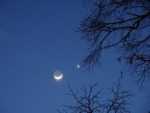Opinion
2009 DD45's near miss
Thursday, March 12, 2009

Moon, Venus
The conjunction of the moon and Venus on Friday, Feb. 27, was a grand sight to behold, almost a repeat of the Jan. 29 conjunction, except this time the pair were much closer. Witness this photo taken by my daughter, Kimberly Bartholomew from her front porch in Imperial.
That whizzing noise you heard on Monday, March 2, was a 40-yard wide chunk of space rock that zipped passed Earth at a distance of about 41,000 miles. Actually, you probably didn't hear it because sound waves do not carry in space, but it was there nonetheless.
The official designation for the chunk of space debris is 2009 DD45, and it was discovered only a few days before it cruised passed us. A distance of 41,000 miles may sound like a lot, but that distance is, in reality, a little more than twice as far as some of the geostationary satellites that give us our weather and communications and one-fifth the distance from Earth to the moon.
Discovered on Friday, Feb. 28, by astronomer Robert McNaught from the Siding Springs Observatory in Australia, the asteroid orbits the sun about every 18 months, and according to estimates, it shouldn't pose any threat to Earth for at least another century.
The space rock is somewhat similar in size to the one that devastated 830 square miles of forest near the Tunguska River in remote Siberia a little over a century ago in June of 1908 with an air blast about 1,000 times more powerful than the atomic bomb used on Hiroshima, Japan.
That blast sent a shock wave around the world that was felt in Great Britain and put enough debris into the atmosphere to cause sky glows that lasted several weeks and were bright enough to be able to read a newspaper. Observers in American noted a decrease in atmospheric transparency lasting for several months due to suspended dust.
If the Richter scale for measuring earthquakes had been invented at that time, it is estimated the blast would have registered energy equal to a 5.0 quake. If a rock that size were to strike near a major city today, with a blast radius of 830 square miles it would prove to be quite devastating.
Such rocks pass Earth all the time. If you have been following the news of late, several reports in the last few months from all around the world of bright meteors in the sky have been received. I have even seen one myself. It was in September of last year while out for an early evening walk that I observed a bright streak traveling from east to west in the northern part of the sky. It lasted an estimated seven to eight seconds and left a bright trail which lasted for another few seconds.
The object did not travel downward so as to strike the Earth. It was traveling in a horizontal fashion and probably skipped off the atmosphere like a rock skipped across the surface of a water pond. Or perhaps the friction of entry burned it up completely.
It was not as big or bright as others observed around the world, but it was an interesting sight to see.
By now you know March has entered like a lamb, at least here in Southwest Nebraska. The good folks along the eastern seacoast and the New England states might disagree with our observation but I will take our 75 degrees against their two feet of snow any day.
SKY WATCH: Full moon on Tuesday, so any early evening observing, even though the temperatures are quite agreeable, will not be profitable even from a dark sky place. Bright Venus will soon leave the evening sky, transferring to be a morning object, more about that next week. Saturn is a nice evening object located below the back part of Leo, the Lion in the early evening sky.
NEXT TIME: More astronomical blathering.

